The National Student Financial Aid Scheme (NSFAS) invites institutions of higher learning, accommodation providers, developers, investors and all relevant individuals or groups who seek to apply for off-take agreements in the provision of student accommodation for NSFAS beneficiaries.
Please note that this process is not applicable to accommodation providers who are currently providing accommodation to NSFAS beneficiaries. It is for underdeveloped and yet-to-be-developed accommodation facilities.
- The granting of the off-take agreements will be subject to:
- National Treasury approval
- Sound business cases
- Meeting the minimum requirements and points
- Demand for accommodation in the proposed area.
NB: NSFAS reserves the right to partially provide off-take agreements for lesser spaces and/or beds than what is applied for.
- Mandatory requirements:
- Over 80% of the proposed beds should be catering to NSFAS beneficiaries
- The proposed cost per bed should not exceed R45 000 per annum
- An undertaking that the envisaged accommodation will meet the
- minimum norms and standards.
Please visit www.nsfas.org.za to apply and ensure you upload all required supporting documents.
Upon completion of the online application form
All requests will be evaluated by NSFAS against a combination of pre-defined mandatory criteria and a point-scoring system, following which the outcome thereof shall be communicated to the successful parties.
NSFAS shall then engage the successful parties to draft, negotiate, complete
and sign the relevant take-off agreement.
Applications will close on 10 November 2022. All applicants must submit all the required supporting documents including business cases where applicable.
The process to accredit existing accommodation is a separate one and its commencement will be announced in due course.
———————————————————————————————-
The future of student funding in Africa
The Association of African Higher Education Financing Agencies (AAHEFA) Annual General Meeting and third International Conference on Financing Higher Education in Africa opened with a question: What is our ‘why’? Victor Kgomoeswana asked the event facilitator and the executive director for marketing and communication at the University of Limpopo. “The minute we forget our ‘why’, we lose our purpose and our drive to bring about change. If this happens we won’t be able to play a part in helping Africa secure a place on the global economic stage.”
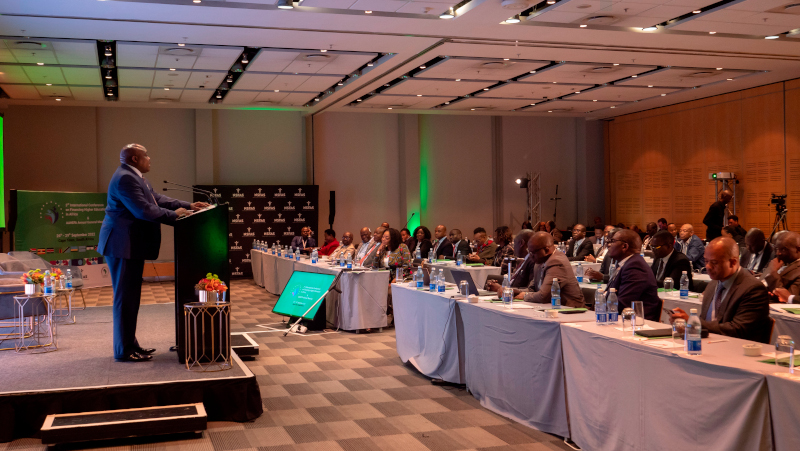 Finding solutions: Ernest Khosa, chairperson of the board for the National Student Financial Aid Scheme (NSFAS), South Africa, addresses the audience at the CTICC.
Finding solutions: Ernest Khosa, chairperson of the board for the National Student Financial Aid Scheme (NSFAS), South Africa, addresses the audience at the CTICC.
The event was held at the Cape Town International Convention Centre (CTICC) recently with the theme The Future of Student Funding and the Sustainability of African Higher Education Financing Agencies: What are the opportunities post Covid-19 Pandemic? Charles Ringera, president of AAHEFA and chief executive of Kenya’s Higher Education Loans Boards (HELB), said: “We have seen loan schemes being launched and soon collapsing. Many of these organisations weren’t set up properly because they had inadequate funds, weren’t able to recover loans, there was a lack of policy support from the government or because there wasn’t a common platform where they could join to learn, improve and share their experiences. In other sectors, professionals like accountants come together to set up associations to grow their network and expand their knowledge.”
Speaking during the opening, Andile Nongogo, chief executive of South Africa’s National Student Financial Aid Scheme (NSFAS), highlighted various problems with higher education funding, noting that all of these come down to affordability and sustainability. “Our higher education funding schemes all exist in the context of shrinking funding from the fiscus and increasing demand in terms of the number of people who want to access higher education but cannot afford to do so.”
He added that Covid-19 has made the situation worse. With the pandemic increasing unemployment rates, many of the people who lost their jobs are looking to higher education to help them secure employment. A conference like this provides a platform for different countries to come together to brainstorm sustainable solutions to common problems. “African problems require African solutions,” he said, noting that this is why an association like AAHEFA is vital.
A common issue that came up at the event was around funding criteria. In order to qualify for many of the funding schemes and financial assistance funds, a student needs to prove that their family’s income is below a certain threshold. “But what if the threshold is R350 000 per year and someone earns R350 001, should they be excluded?” asked NSFAS chairperson, Ernest Khosa. This issue has also been flagged by South Africa’s minister of higher education, science and innovation, Dr Blade Nzimande, who noted at the end of 2021 that the government was working towards providing support to higher education students who find themselves in this “missing middle” income bracket. Another debate unpacked whether or not funding for certain degrees — particularly those that address critical skills shortages faced by a country — should be favoured over others.
While a common sentiment throughout the event was that higher education financing is under threat, Ringera and others stressed that Africa is an incredibly resourceful continent, full of potential and capable of coming up with ways to do things differently. Given the fact that Africa has the youngest and fastest-growing population in the world, this presents an opportunity and a challenge.
The challenge is to ensure that funding models are geared to enable young people to acquire the skills they need to thrive and to provide the market with what it needs. The opportunity is for universities to shape these young people into the bright minds needed to transform the global economy. But just securing more government funding isn’t enough. To capitalise on this opportunity, attendees agreed that it is essential to diversify sources of financing, revisit funding criteria, explore alternative types of learning and come up with strategies to ensure that loans are repaid. In line with this, data and new technologies were cited as enablers to up efficiency and ensure the successful running of these funds.
 Best practices: Professor Ramneek Ahluwalia, chief executive of Higher Health.
Best practices: Professor Ramneek Ahluwalia, chief executive of Higher Health.
“If we want to be a part of the global village, we need to use these innovations to better do the work we do,” said Ringera. “We witnessed the potential of connectivity and digital tools and technologies during the pandemic, when we saw that the future of education does not lie in the classroom. More and more, studies can happen anywhere, virtually,” he explained, highlighting the value of digital access to enable customised learning and funding.
Given the general lack of funds, TVET programmes were touted as a viable alternative to traditional university degrees as they equip young people to get jobs, faster. A TVET qualification is usually shorter and cheaper to obtain, so students are getting into the workforce a lot faster. Where university programmes are geared towards the transfer of knowledge, TVET colleges focus on teaching valuable skills.
By matching training and education with market requirements, Basani Hlekane, acting chief executive at Vhembe TVET College, outlined that TVET colleges can offer programmes that address the needs of industries and communities. For example, Vhembe partners with corporates to offer training geared specifically at upskilling their employees.
It isn’t only about funding. It is essential that African financing agencies go beyond money, attendees at the event heard. Financing without proper student support is a recipe for disaster, advised Professor Ramneek Ahluwalia, chief executive of Higher Health, a South African agency that promotes the health and well-being of students across South Africa’s universities and TVET colleges. “If we want to ensure the sustainability of the industry, we can’t have funding conversations without having conversations about mental health and wellbeing,” Ahluwalia said.
“These funds are mandated by governments to build the skills economy for our country and for the continent. They are given a sum of money to fight poverty by changing the lives of the most underprivileged individuals. But if we hand out money without addressing broader mental health and social challenges, we’re not going to get the return on investment we want. If we aren’t helping our young people to handle all of the anxiety and stress they have to deal with on a daily basis, how can we expect them to pass their exams,” asked Ahluwalia. South African research shows that only 50% of students pass, he said, noting that only 25% of this half finish their degree in time and the other 75% take as long as 10 years to complete their studies. “Yes, money is a solution to the skills crisis but if we neglect the other issues that are present in our society, we are fighting a losing battle.”
Kgomoeswana summed up the importance of the event and the conversations being had when he unpacked gross enrollment rate figures from across the globe. These numbers represent the total enrollment in higher education expressed as a percentage of the population in the official age group corresponding to this level of education. In sub-Saharan Africa, this number is well below 10%. In America, these numbers are close to 90%. If the majority of young people in sub-Saharan Africa aren’t able to access tertiary education, it’s inevitable that Africa will fall behind. “At the start of this, when I said, let’s remember our ‘why’ I meant that we need to remember what is at stake if we don’t address the issue of funding. If we don’t get it right, we are not only risking the faltering of higher education systems, we run the risk of broader socio-political and socio-economic instability.”
———————————————————————————————-
AAHEFA president on opportunities, challenges and responding to Covid-19
‘It feels good to be back and to get this opportunity to discuss important policies and to identify new opportunities post-Covid,” said Charles Ringera, president of AAHEFA and chief executive of Kenya’s Higher Education Loans Boards (HELB), told Mail & Guardian. “You can see that members have missed one another and they are keen to have these debates and discussions.”
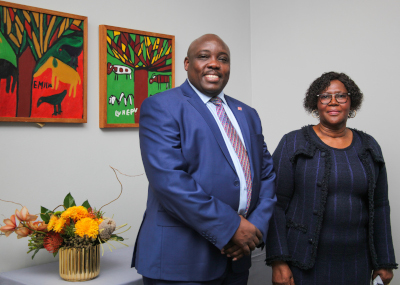 Lessons from the pandemic: Charles Ringera, president of AAHEFA and chief executive of Kenya’s Higher Education Loans Boards, with Professor Xoliswa Mtose, vice chancellor at the University of Zululand.
Lessons from the pandemic: Charles Ringera, president of AAHEFA and chief executive of Kenya’s Higher Education Loans Boards, with Professor Xoliswa Mtose, vice chancellor at the University of Zululand.
According to Ringera, the pandemic taught him so much about what is, and isn’t, possible when it comes to learning across Africa. “We have seen how learning can take place anywhere,” he said, noting that there is potential for digital learning to democratise higher education because it makes it possible for universities to enrol more students online. This could make tertiary education more affordable. “Beyond this, the pandemic has shown us how technology can be a medium for delivery of other things too,” added Ringera, such as the potential for these technologies to simplify the allocation of funds and the process of deciding how to award money to students.
Addressing the challenges faced by funding schemes and institutions and the complexities that these create, Ringera said that funds must cater to market needs.
While some of his colleagues may have different opinions on this point, he is adamant that we need to use what we have to fund students who are studying to gain the skills the market requires and that are the most in-demand.
“It’s no surprise that we have meagre resources. We need to listen to the market and direct our funding towards the skills the market needs. If not, students will walk out of university with a degree and they won’t be able to find jobs.” However, finding the funds to help these studies is a major stumbling block. “In Kenya, about 27% of the GDP is earmarked towards education. Is this enough? No. The money we have isn’t sufficient to meet the demand.” For Ringera, this reality means that financing schemes and funds need to consider alternatives — a topic that was widely discussed during the two-day conference. “We’ve all heard the analogy about it taking a village to raise a child. When it comes to higher education funding, we need that village. And where policies are not in place to support the efforts of funding institutions, there is room to champion this cause to bodies like the African Union,” he said.
As the AAHEFA president, Ringera hopes that the conference will serve as a platform for important policy dialogues, understanding that the needs and hurdles in different environments, and the legislation dictating how money is allocated/spent, are very different. “We know that the social fabric of each country is different. So we need to listen to what the different countries are doing and then take what we’ve gained from these discussions and customise it for our specific region. These discussions will be richer, the more people we get to join.”
AAHEFA has 11 member countries, which amounts to about 20% of the continent.
“Africa’s potential is immense. And this potential lies with our youth. This is a gemstone that we can sell to the rest of the world. But we can’t send these people out into the world if they are semi-skilled or unskilled. This is why skill acquisition is so important and also why we all need to participate in conversations around higher education funding. In doing this, we can make sure that every child of Africa can gain the skills they need to participate economically and productively in the global economy.”
———————————————————————————————-
How NSFAS is transforming lives
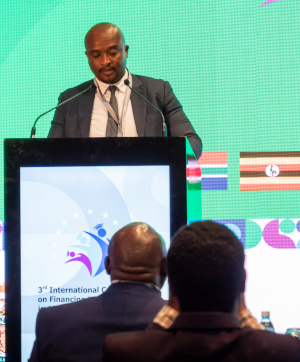 Empowerment through education: Andile Nongogo, chief executive of NSFAS.
Empowerment through education: Andile Nongogo, chief executive of NSFAS.
National Student Financial Aid Scheme (NSFAS) was established to enable poor students who would not otherwise be able to attend college and university to access higher education. NSFAS chief executive Andile Nongogo describes this student funding scheme as “the single-most successful, transformative programme of government in terms of changing people’s lives”.
Nongogo said that in taking a person to school, you afford them the opportunity to find employment or start their own business. This empowers them to change their circumstances. But doing this work isn’t simple. Combine the impact of the pandemic, with the knock-on effects of last year’s unrest and the global economic downturn and what you have is a lot of people who have fallen on hard times. “Even people who would have been able to afford to send their kids to school are finding it difficult. This increases the demand for students to be funded by the government,” he outlined.
One of the biggest challenges NSFAS faces is around available funding versus the demand for funding. While NSFAS has established some stability by making strict funding provisions for the next three years, Nongogo admitted that the question of sustainability remains. This is why Higher Education and Training minister Blade Nzimande has established a task team to look into the future of NSFAS and to explore alternative funding models. Nongogo cited accessing the data they need to make the right funding decisions, quickly, as another administrative hurdle. To qualify for NSFAS funding, the household income needs to be below a certain threshold.
“The most credible source we can get for household income is Sars data. But the timing of tax data being available and the exchange of data between Sars and NSFAS tends to be an issue. Similarly, to verify whether or not a student or beneficiary is who they say they are, you need a link to the Home Affairs database.” This can also prove complicated. Once a funding decision is made, the money isn’t awarded immediately. NSFAS needs confirmation of a student’s registration before they can pay the funds. Over the course of the two-day AAHEFA conference, it was clear that NSFAS’s challenges are not unique, which is why events like these are so valuable because they bring people together to come up with solutions to common problems.
Nongogo cited a trip to Nairobi prior to the conference as a prime example of why it’s important for different funds and financing schemes to collaborate. During this trip, he and his team learned more about how Kenya’s Higher Education Loans Boards (HELB) is using technology to improve loan recoveries, as well as how they are encouraging people living on the outskirts of society to apply to universities.
“Engagements like this provide a platform where we can share our experiences, with the hope being to create some sort of cohesion from African governments around higher education funding policy,” he said. As the host of this year’s event, Nongogo believes that the success of the event depends on deriving value beyond the conference and demands that the attendees be very deliberate about action and what they hope to get out of it.
“If we look at the theme of the 2022 conference; it’s around the sustainability of higher education financing institutions. One thing is clear – our governments have almost reached their maximum in terms of funding.” He said they need to ask the right questions to come up with ideas to address this issue:
- Where else do we go to raise funds?
- Are we funding the right qualifications to support our respective economies?
For Nongogo, if the conference can provide answers to questions like these, it will have been a success. “As NSFAS, part of our mandate is to advise the minister on matters affecting student-funding policy. And we hope to take some of the lessons we’ve learned at this event and use these to shape future policy.”
———————————————————————————————-
Student funding with sustainability in mind
Today, more than 60% of Africa’s population is under the age of 25 and by 2030, young Africans are expected to constitute 42% of global youth, according to the United Nations. But these young people must be equipped with the skills needed to participate in an increasingly evolving knowledge economy. Therefore, universities have a critical role to play in the continent’s development battle.
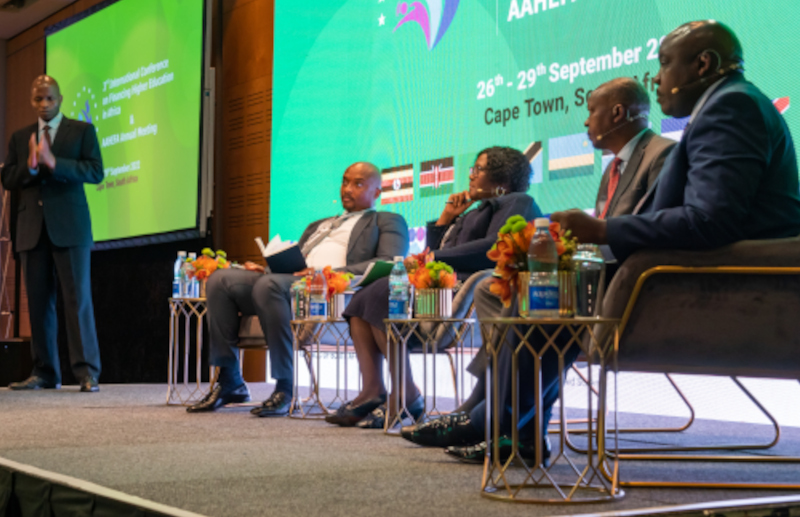 Missing middle: NSFAS CEO Andile Nongogo leads the panel discussion on the first morning. Panellists included Professor Xoliswa Mtose (centre), vice chancellor at the University of Zululand (center), who said partnership rather than competition was needed among institutions so that resources and knowledge can be shared.
Missing middle: NSFAS CEO Andile Nongogo leads the panel discussion on the first morning. Panellists included Professor Xoliswa Mtose (centre), vice chancellor at the University of Zululand (center), who said partnership rather than competition was needed among institutions so that resources and knowledge can be shared.
Our African reality is that if we don’t strategically invest in tertiary education, we are producing a generation that is not empowered to participate in local and international markets. They will not have the skills the global workforce needs. And they will not be able to improve their lives and the lives of those around them. This was the opening sentiment of a panel discussion held on the first morning of the African Higher Education Financing Agencies (AAHEFA) event. The panellists agreed that you can’t talk about education without talking about financing. But finding sustainable ways to deliver this financing is a challenge. You have to innovate or you will be left behind, they said. This is true both on a global scale and within African countries where massive divides exist between people living in urban and rural settings.
Speaking as part of this panel, Professor Xoliswa Mtose, vice chancellor at the University of Zululand, noted that this is a reality she experiences working at a historically disadvantaged institution located in an area that serves learners who are from poorer backgrounds. “The most important thing for me as a leader of an institution like this is that the quality of education we deliver means that our students are equally equipped when they leave us,” she said.
Noting that many of the students who attend the University of Zululand view higher education as a means to move out of poverty, Mtose highlighted that they are often more driven to really capitalise on the opportunity they have been given because it serves as a real chance for them to change their lives. And yet there is not enough funding to provide these young people with this opportunity. The imbalance between funding supply and demand was the impetus behind #feesmustfall. This student-led movement started in South Africa in 2015 and saw students protesting against fee increases and calling for the cancellation of historical debt and an increase in government funding for universities.
As someone who is awarding funds, this is a conundrum that Andile Nongogo, chief executive of the National Student Financial Aid Scheme (NSFAS), has to deal with every day. According to Nongogo, NSFAS has a bias towards previously disadvantaged institutions because the aim of the scheme is to give funding to students who do not have the financial means to afford attending university.
So, what does sustainable financing mean? According to the panel, it comes down to providing support to students and finding alternative sources of funds so that it is possible to expand the criteria used to determine who qualifies for funding. In addition, it means collaborating with the private sector to identify critical skills so that we can potentially prioritise these and channel funds towards qualifications that bring about the best returns.
As a starting point, it was stressed that funding has to come with support. When students from the most impoverished backgrounds are thrown into a large university setting, they often struggle to cope. If they aren’t given the necessary support they need to ensure their well-being and to help them make the transition from school into university and then into the working world, there is a risk that they will fail. And if these students drop out, the money allocated to pay for their studies has gone to waste. In providing support to students and providing them with the necessary mentorship, funding schemes are essentially protecting their investments.
For Mtose, sustainability is about looking for alternative sources of funding, noting that there is incredible value in getting industry involved. She explained that the University of Zululand has just launched a new engineering programme. “For me, it was most important to look at the industry we are training these people for. When it comes to curriculum development and actually putting together the training, it’s important to bring these people from the industry on board so that we can build a curriculum that meets their expectations. People value where they put their money. They’re not going to put their money somewhere without a promise of a return and so when we bring industry in and they fund our students, they are more invested in supporting student success.”
Mtose said collaboration, rather than competition, among institutions can also help funding institutions spend their money more thoughtfully. For example, if you look at the science faculties and the different types of equipment they need, why not share these resources where possible, she asked.“Competition between institutions of higher learning benefits no one. It is unhealthy. Why not double up on resources and partner with other institutions to use the resources we have more effectively.”
According to the panel, the “missing middle” group of students come from working-class households but do not qualify for funding. Mtose said a hybrid funding scheme, offering a combination of grants and loans funded by the government and the private sector could address this issue by providing further funding to those who currently don’t qualify. Addressing a contentious topic, the panellists also spoke about the idea of providing more funding for “government priority programmes” that build skills that are particularly relevant to the economy.
This approach means that funding for certain degrees is harder to come by and, thus, could make it harder for people to complete these qualifications. One comment from the audience expressed concern about this approach, noting that universities are designed to produce knowledge that blends with practice and contested that there is no single unit of knowledge or discipline that is “irrelevant”. But the panellists contested that where resources are scarce, you need to direct them as productively as possible and this means developing the talent the country needs to fill critical skills shortages.
“Indeed, there should be scope for us to look at the qualifications that are most needed by the economy instead of having an open-ended approach where we are trying to fund everybody,” said Nongogo. It comes down to funding students for employment, not unemployment, agreed Charles Ringera, president of AAHEFA and chief executive of Kenya’s Higher Education Loans Boards (HELB). “If we don’t need more teachers, why should the government be applying the meagre resources we have to funding teaching and producing more teachers,” he said, adding that sustainability of student funding demands that we listen to the market.
If we don’t take care of the young people, we will create a scenario where it is the young versus the old and this is not the kind of situation Africa wants to find itself in, one panellist said. Ringera agreed, saying: “If we are to progress as countries and as a continent, our scholarship funds and financing schemes need to move forward. In learning from different models and working together, there is a lot we can do to address our issues and improve our situation.”
———————————————————————————————-
Learning student financing lessons from our African neighbours
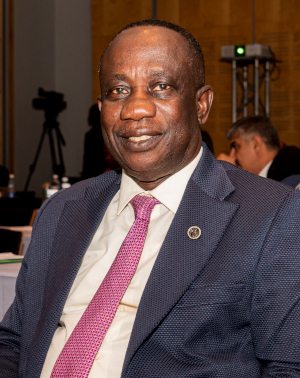 Opening doors of learning: Nana Kwaku Agyei Yeboah, chief executive of the Student Loan Trust Fund in Ghana, where high school education is free.
Opening doors of learning: Nana Kwaku Agyei Yeboah, chief executive of the Student Loan Trust Fund in Ghana, where high school education is free.
While each country has different approaches to student funding, as well as different policies and regulations in place, many of the financing agencies and institutions at the AAHEFA event face common challenges. And most have to do with a lack of funds and an inability to recover funds.
Chatting to Mail & Guardian, Nana Kwaku Agyei Yeboah, chief executive of Ghana’s Students Loan Trust Fund (SLTF) explained that the government has embarked on various ambitious education initiatives. For example, high school education in Ghana is free. “Many of the people who wouldn’t have been able to afford high school, can now attend.”
At the same time, the government hopes to double the gross tertiary enrolment ratio from 20% currently to 40% by 2030.
To make this more viable, SLTF has launched a “no guarantor” student loan policy. Before this policy, students had to have a guarantor before their loan applications were approved. SLTF data shows that over 90% of the eligible student population weren’t able to secure loans, in part, because of difficulty in finding guarantors. The removal of the guarantor requirement puts tertiary education within the reach of hundreds of thousands of students nationwide, said Yeboah.
In Zambia and Tanzania, funding challenges stem from the mismatch between the number of eligible students who want to attend university and the amount of money available to fund them. The number of students completing high school and who qualify for university is huge, said a representative from Zambia’s Higher Education Loans and Scholarship Board (HELSB). Some can sponsor themselves, but the majority depend on government assistance in the form of loans.
“We are allocated a fixed amount of money as part of the national budget and we have to finance all the students from this amount.” However, they are not able to finance everyone. HELSB has created a points system to determine how the funds are distributed. It doesn’t matter what programme a student applies for, if they have a certain number of points, they qualify for funding.
He admits that this approach is contentious for two reasons. Firstly, how can we say “no” to a student who is just a single point below the threshold, he asks. And secondly, by funding students irrespective of their degree of choice, he worries that HELSB may be failing on its objective. If we want to build the labour power and skills our country needs, we need to group students into different categories, with some categories ‘favoured’ over others based on the skills the country needs. If we are training someone for the sake of training and they can’t find a job, they won’t be able to repay their loan.” In line with this, he points out that loan recovery is a major priority for HELSB. By improving recoveries, they can use the money that is repaid to fund others.
According to Tanzania’s Carolyne Nombo, given the fact that government funding is insufficient, the Higher Education Students Loan Board (HESLB) is engaging with the private sector to boost their coffers. “The government is doing a lot but there are gaps. We know that the private sector absorbs our graduates so we are encouraging them to incur some of the costs to train the people they want to one day bring into their workplaces.” Their efforts have borne fruit. In the current financial year, HESLB has secured a loan worth TZS 200-billion (R1.5-billion) to fund students who meet the requirements to study at their chosen university or TVET College.
In Namibia there also exists a gap between the demand for funding and supply, says Kennedy Kandume, chief executive of the Namibia Students’ Financial Assistance Fund (NSFAF). Noting that they are constantly engaging with the government about increasing this budget, he highlights that just because the government allocates more to funding for higher education one year does not mean that the same will happen the following year. Agencies like NSFAF are supposed to function as a revolving loan fund and so loans are made available to students who are then required to repay the money so that the central fund is replenished. As individuals pay back their loans, there is an opportunity to issue loans to new students. “Some people who have benefited from the fund aren’t willing [or able] to pay back the money. This is a problem.”
Like many of his colleagues, Kandume worries about funding students who won’t be able to find work after completing their studies because there is no demand for their skills. In the case of loan repayments, this reality only exacerbates the problem.
Kandume fears that in targeting funding at “in-demand” sectors, they may find themselves with an over-saturated market. Despite these challenges, he is steadfast that you can’t stop funding students just because there are limited funds and a lack of employment opportunities. “In our interactions with other countries, it’s evident that when you have an educated population, these people will find a way to navigate the job market and make opportunities for themselves.”
All over the world, student loan financing is a challenge, concluded Yeboah. Even in the most advanced countries. Participants agreed that associations like AAHEFA add value and have an important role to play in enabling funding schemes to brainstorm innovative and creative ways to improve the work they do.
———————————————————————————————-
Setting goals for AAHEFA Namibia 2023
The Each One, Teach One concept is all about paying it forward. Passing on what you’ve learned to others and spreading knowledge for the betterment of your community. This is the message that Kennedy Kandume, chief executive of the Namibia Student Financial Assistance Fund (NSFAF) will be taking away from the Association of African Higher Education Financing Agencies’ event in Cape Town last week.
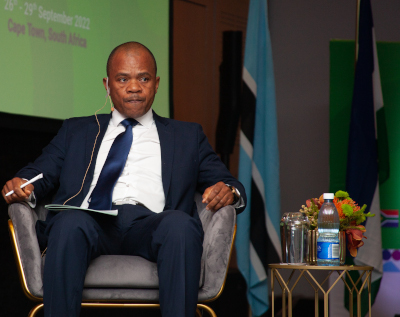 Beyond borders: Kennedy Kandume, acting chief executive of Namibia Students Financial Assistance Fund.
Beyond borders: Kennedy Kandume, acting chief executive of Namibia Students Financial Assistance Fund.
“We can learn so much from the experiences of other countries. Looking at what they do and where they succeed and taking this information home to help us improve our work, strengthen policy and boost operational efficiency.”
As the host of next year’s AAHEFA conference and general meeting, Kandume plans to do a comprehensive “post mortem” of the 2022 event to assess what went well, what went wrong and how to improve on what the event offers to attendees.
While he hopes to continue the tradition of having representatives from different AAHEFA member countries speaking at the event, Kandume is also keen to invite speakers from outside of Africa to share their insight around student-funding challenges. In some countries across Europe, there are no tuition fees for local students. Meanwhile in the US, almost three quarters of universities are facing financial hurdles.
“We are thinking of reaching out to speakers from outside the continent and inviting them to bring fresh insight to the table. While it is important for us to share our experiences with each other as Africans and to develop African solutions to African problems, there is a lot we can learn from other countries around the world.” Keen to ensure that AAHEFA members gain something tangible from their membership, Kandume asserted that the appointment of an AAHEFA secretariat, a permanent administrative office or department, is imperative. He believes that AAHEFA needs a proactive secretariat in place that will regularly visit the member countries to engage with them on what they are doing and share best practices. In this way, AAHEFA will continuously add value to member countries beyond the annual debates and dialogue.
Articles written by Joanne Carew